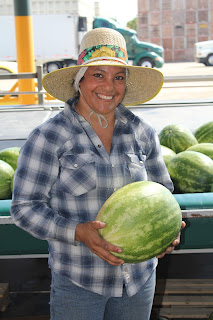 |
| Packing melons near Stockton |
In the war over the safest, tastiest way to grow apples, oranges and rutabagas, the prize is dietary superiority. It’s religious strife with a tinge of class warfare. The dividing line in this struggle is money—the cost of production, the cost to the consumer. Stanford University Medical Center released a comprehensive study recently that intensified the food fight between the organic/orthodox right and the conventional/atheist left.
The underlying truth that emerged in the study is this: There's little evidence organic foods are nutritionally superior to their conventionally grown counterparts. Both use dirt, water and chemicals to produce crops.
Yes, it’s true. Organic crops are produced with chemistry, just not
the same compounds as conventionally grown crops. The U.S. Department of
Agriculture permits use on organic crops of alcohol, sulfur, lignin and
magnesium sulfate and streptomycin, as well as a very long list of other
compounds. The U.S. Environmental Protection Agency
says: "Organically
grown" food is food grown and processed using no synthetic fertilizers or
pesticides. Pesticides derived from natural sources (such as biological
pesticides) may be used in producing organically grown food.
The federal code for the National Organics Program says: "When the practices provided for in paragraphs (a) through (d) of this section are insufficient to prevent or control crop pests, weeds, and diseases, a biological or botanical substance or a substance included on the National List of synthetic substances allowed for use in organic crop production may be applied to prevent, suppress, or control pests, weeds, or diseases: Provided, That, the conditions for using the substance are documented in the organic system plan."
The federal code for the National Organics Program says: "When the practices provided for in paragraphs (a) through (d) of this section are insufficient to prevent or control crop pests, weeds, and diseases, a biological or botanical substance or a substance included on the National List of synthetic substances allowed for use in organic crop production may be applied to prevent, suppress, or control pests, weeds, or diseases: Provided, That, the conditions for using the substance are documented in the organic system plan."
Until recently, nobody bothered to look at the toxic effects of natural chemicals (such as organic pesticides), because it was assumed they posed little risk. But when the studies were done, the results were somewhat shocking: University of California researchers found about half the natural chemicals studied are carcinogenic.
This is a case where everyone (consumers, farmers, researchers) made the same mistake. Everyone assumed that "natural" chemicals were automatically better and safer than synthetic materials, and we were wrong. Researchers suggest it's important to be more prudent in the acceptance of "natural" as being innocuous and harmless. But, the truth is this, when chemicals are detected on U.S.-grown produce, whether organic or conventionally grown, the levels are minuscule. America has the safest food supply in the world, regardless of growing procedures.
In 2009, the American Journal of Clinical Nutrition published a report with conclusions similar to the Stanford study, Nutritional Quality of Organic Foods: a Systematic Review. Both these studies were meta-analyses, meaning that highly qualified teams gathered and studied numerous research papers on both sides of the argument before concluding that when it comes to nutrition, farming is farming. The approaches by organic farmers, where they differ from the approach of conventional growers, had little or no impact on nutrition or residue toxicity.
“These results are hardly surprising when one
considers that nutrition is dependant on a host of issues, starting with the
variety of the plant or animal,” said Maurice
Hladik, author of Demystifying Food From Farm to Fork.
“For example, hard red spring wheat has higher protein content than soft winter
wheat, and Jersey cows tend to produce milk with higher butterfat content than
black and white Holstein Frisians. Then there are a slew of other factors,
including the maturity of whatever is grown at harvest, length of time in
storage, the variables of humidity and conditions in transport, plus many more.
Whew! With so many factors influencing nutrition, it isn’t surprising that a
handful of farming practices would make little difference.”
Hladik said the Stanford paper does point out that
while both types of foods contain chemical residues, the likelihood of
encountering them on organic products is less than the conventional option.
However, all foods were within safety levels when it came to potential toxicity exposure.
“Understandably, the proponents of organic foods wish
to protect their brand and find fault with the methodology of these two reports,
but do not seem to make any serious attempt to muster the evidence to counter
these conclusions,” Hladik notes. “Others point out that organic is more than
nutrition,”
Followers of organic food religions believe that organically grown food offers such important factors as flavor benefits and sustainability back on the farm. But, the truth is farmers, regardless of approach, need to preserve their growing medium and contain production costs while providing food consumers want and need.
“I am not so certain that organic farming is
particularly sustainable,” Hladik said. “Most science-based yield studies in
Canada and the United States have organic output per acre averaging about 75
percent of ‘conventional’ agriculture. If organic farming ever became
mainstream, (US Census data has less than one percent of farmers and also
farmland dedicated to the practice), either a lot of people would go hungry or
substantially more rain forest would be in jeopardy. Using more land to feed the
world seems to be the antithesis of sustainability.”
Bottom Line, he says: “For consumers convinced that
organic is better, by all means maintain your devotion. For those consumers who
may appreciate the lower cost of conventional food, they do not seem to be
compromising safety, nutrition or flavor at the dinner table.”

No comments:
Post a Comment